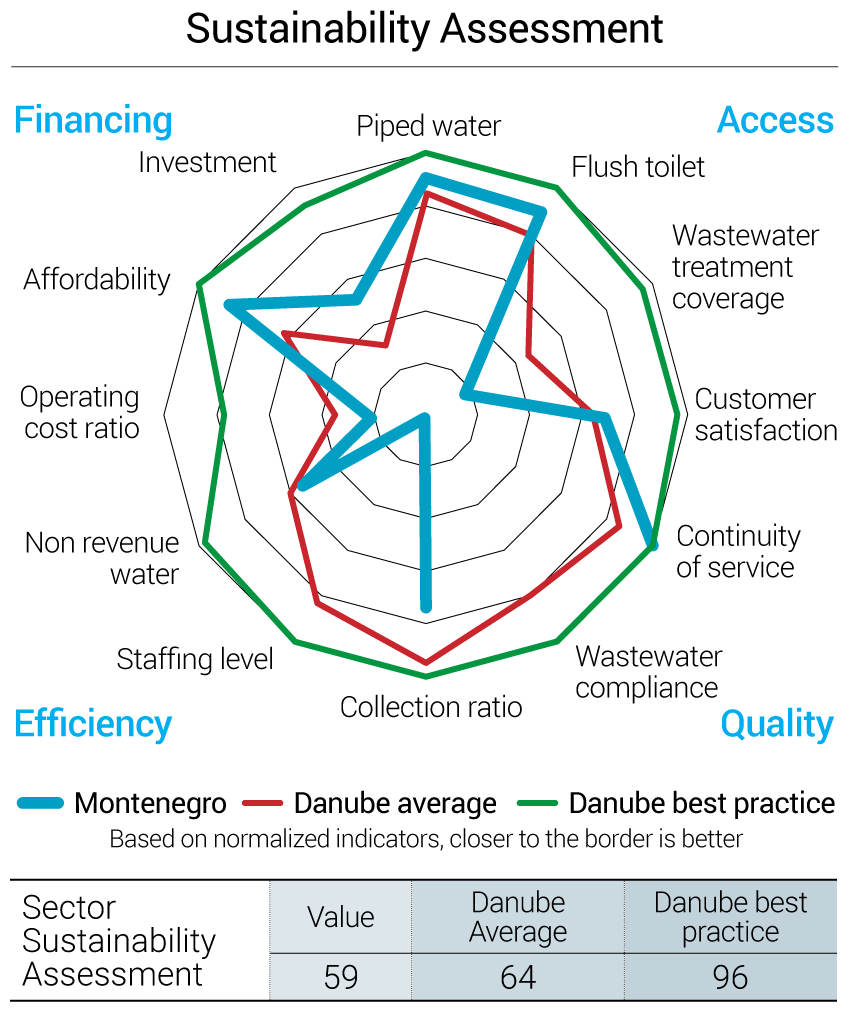 MOntenegro
MOntenegro
- Water Snapshot
- Context for Services
- Organization for Services
- Access to Services
- Performance of Services
- Financing of Services
- Water Sector Sustainability and Main Challenges
- Sources
WATER SNAPSHOT
Sources for all numbers in the snapshot are provided in full in the body of this country page; a complete description of the methodology is provided in the State of the Sector Regional Report available under SoS.danubis.org/Report.
 |
 |

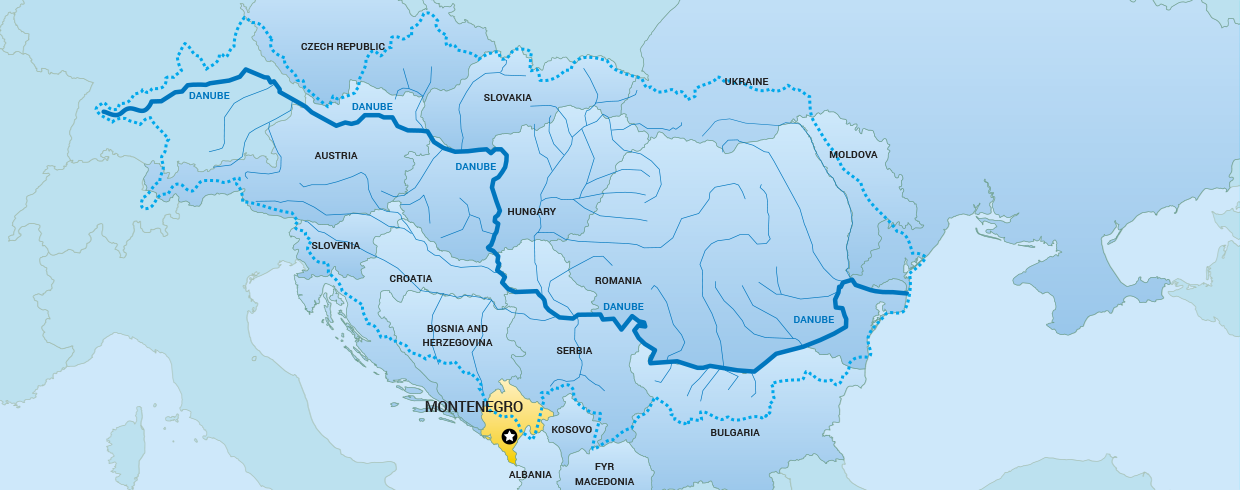
KEY WATER AND SANITATION SECTOR CHALLENGES
- Financing investments to upgrade the water and wastewater sector infrastructure. The second phase of the national Master Plan Implementation requires infrastructure investments for both water and sanitation in order to comply with EU directives by 2030. Those investments are estimated at around €640 million over the next 15 years, or nearly double the current level of investment.
- Improving the efficiency and cost-effectiveness of water utilities. Efficiency and performance of water utilities are a challenge that will require addressing issues such as overstaffing and excessive nonrevenue water levels.
- Implementing sound cost recovery principles. Water utilities do not generate sufficient revenues to ensure proper maintenance and sustainability of infrastructure. To reverse this trend and address this issue, tariffs may need to be reviewed according to sound cost recovery principles.
FURTHER RESOURCES
On water services in the Danube Region
- A regional report analyzing the State of Sector in the region, as well as detailed country notes for15 additional countries, are available under SoS.danubis.org
- Detailed utility performance data is accessible, if available, under www.danubis.org/database
On water services in Montenegro
The following documents are recommended for further reading; the documents, and more, are available at www.danubis.org/eng/country-resources/montenegro/
- Gov. ME. 2011. Strategy of Public Administration Reform in Montenegro. Podgorica: Government of Montenegro.
- ICPDR. 2010. Danube Facts and Figures: Montenegro. Vienna: International Commission for the Protection of the Danube River.
CONTEXT FOR SERVICES

- Economy. Montenegro has a developing economy with important regional disparities. Its 0.6M inhabitants are mainly located in the central and southern parts of the country. The Montenegrin economy is characterized by low labor productivity, import dependence, high unemployment, and undeveloped financial institutions and capital markets. The average GDP per capita of US$14,318 PPP reflects this overall situation. Montenegro also shows significant local disparities in level of development. The northern part of the country has a higher rate of unemployment and a lower income per capita than the central and coastal areas (CIA 2015). Roma (1%) and Egyptians (0.3%) are the most vulnerable marginalized minorities (Monstat 2011). Since December 2010, Montenegro has been an official candidate for EU membership.
- Governance. Public administration is organized at the national and municipal levels. Montenegro is a parliamentary republic with 23 municipalities and no administrative regions. Local self-governments perform activities such as local development planning and program implementation, and provision of local public utility services including water and wastewater services (Gov. ME 2011).
- Water resources. Montenegro has sufficient water resources, but they are unevenly distributed across the country. Ninety-five percent of Montenegrin watercourses are formed within the country (i.e., both the sources and a major part of the drainage basins occur within national boundaries). This minimizes cross-border impacts on Montenegrin waters, but also engenders responsibility for the quality and distribution of water, which then flows into neighbouring countries. Rainfall in Montenegro is characterized by high variability in both time and space. The country has good-quality groundwater and surface water, but these resources are unevenly distributed throughout the country. Karst areas in the central and western parts are arid, whereas the northern mountainous area is richer in raw water. About half the country belongs to the Danube catchment and the other half to the Adriatic catchment. Flood water potentially threatens 24,500 hectares of farmland and urban areas. Central and northern parts of the country were hit by large floods in 1963, 1979, 1999, and 2000, causing power outages, landslides, and damage to water and wastewater infrastructure, resulting in serious drinking water shortages (ICPDR 2010). Concerning long-term climate variations, the yield of water sources will be reduced, and some springs will dry up or experience intermittent flow. As a result, accumulations used for industrial and commercial purposes will decrease, as will hydropower generation, resulting in an increase in electricity imports. The southern parts of the country are likely to be most vulnerable to climate change (Gov. ME 2010). However, no specific strategies have been implemented to address this likelihood.
- Water supply sources. Public water utilities use groundwater to produce drinking water. In 2012, 114Mm3 of water were abstracted for public water supply, 90% of which came from groundwater. Industrial facilities use raw water, approximately two-thirds of which comes from surface water and one-third from groundwater. Prevailing pollutants are mainly the result of wastewater from point sources. Industrial wastewater treatment is performed in only a few industrial plants, and there are only four municipal wastewater treatment plants for the whole country. In coastal areas, wastewater is discharged directly into the sea (ICPDR 2010).
ORGANIZATION FOR SERVICES


Service provision. Municipalities provide water and wastewater services to their population. Local governments are responsible for water and wastewater services and provide them through 22 public utility companies. Fifteen municipal utilities that provide only water and sanitation services cover urban areas representing 50% of the population. Six municipal multi-utility companies supply mostly small municipalities (18% of the population) (Figure 1). One regional water company owned by the central state has been specifically created to supply water to coastal municipalities (8% of the population). With an average population served of 21,466, the Montenegrin water sector appears fragmented compared to other Danube countries.
Policy-making and sector institutions. The sector is controlled and regulated at the national level by several ministries, with one clear line ministry. As shown in Figure 2, local water and wastewater service providers are regulated and controlled by five national institutions:
- The Ministry of Agriculture and Rural Development is the line ministry responsible and competent for proposing and implementing water policy, and for the adoption of planning documents and normative acts. The Water Directorate has jurisdiction to enforce laws, and to prepare technical bases for regulations, plans, and programs adopted by the government and the Ministry of Agriculture and Rural Development (MPR 2015).
- The Ministry of Sustainable Development and Tourism is accountable for issues related to the sustainable use of natural resources and integrated management of the sea from pollution. It is in charge of municipal wastewater activities management and coordination of regional water supply systems for which it monitors implementation of the various projects defined in the strategic planning documents (MRT 2015).
- The Institute for Public Health is responsible for drinking water quality control (IJZCG 2015).
- The Agency for Environmental Protection within the Ministry of Spatial Planning and Environmental Protection is responsible for setting sewerage effluent treatment and discharge quality standards, permitting of sewerage treatment facilities, sewerage sludge processing, and monitoring of compliance with established standards (EPA 2015).
- The Ministry of Finance is responsible for reviewing and regulating annual financial statements from water and sewerage utilities (MIF 2015).

Capacity and training. Staff capacity building and training remain an important issue in the water sector. Water services management staff are appointed by municipal representatives with no specific qualification or experience requirements. This results in significant turnover according to political cycles, and appointment of management personnel who lack appropriate skills and competencies. Moreover, water utilities technical staff receive almost no training, which prevents efficiency gains in technical operations and utilities management. As a consequence, there is considerable room for improvement of staff training and for development of staff capacity in the water sector. Currently, the national water association, which comprises the 21 directors of public water and wastewater utilities, is the main provider of training, technical assistance, and knowledge exchange activities (workshops, conferences, journal) to water stakeholders.
Economic regulation. Water tariffs are set at the local level and water utilities financial statements are reviewed annually by the Ministry of Finance. The water sector in Montenegro is regulated through a public self-regulated model, since there is no national regulation agency and no official national benchmarking system. Tariffs are revised upon request of utilities. Utility managers submit a new tariff proposal to the utility management board. If accepted, a proposal of decree on tariff changes must then to be approved by the local municipality. Water and wastewater utilities must submit their annual financial statement to the Tax Administration Head Office (under the Ministry of Finance) for financial inspection (MIF 2015).
Ongoing or planned reforms. Administrative reforms are still at a preparatory stage. The Public Administration Reform Strategy in Montenegro for 2011-2016 provides a comprehensive framework summarizing the main targets and domains of the administration reform process at both the national and local levels. However, the objectives stated in this document are still at a preparatory stage and will probably be implemented under the umbrella of EU harmonization in the coming decade. The objectives applying to water and wastewater utilities are likely to focus on (a) implementation of full production cost recovery to enhance utility sustainability, and (b) the regionalization of service delivery to improve operation and capital efficiency via economies of scale (Gov. ME 2011).
ACCESS TO SERVICES

Service coverage. Service coverage in urban areas is much better than in rural areas. Montenegro provides good access to piped water (91%) and sanitation (89%) services (Figure 3). However, access to publicly provided services is much lower. Approximately 76% of the Montenegrin population is connected to the public water supply and 43% to sewerage. Only 18% of all wastewater produced is effectively treated, mostly below the Urban Waste Water Treatment Directive standards, resulting in significant environmental and public health hazards. However, the situation in urban and rural areas is markedly disparate. In urban areas, more than 98% of the population has access to a public water supply and 71% has sewerage services. To improve wastewater treatment, construction of 6 treatment plants (totaling 485,800 population equivalent) is planned during 2014 to 2016. The two largest plants will provide tertiary treatment, and the other four will provide secondary treatment.
Montenegro Data Availability
Overall data availability could be improved, especially for information on water sector funding and spending. Moreover, some operational data are available for only a limited number of years, which prevents medium-term trend analysis.

Equity of access to services. Three-quarters of minority populations have access to piped water supply. Access to piped water and flush toilets for the bottom 40% of the population is quite high at, respectively, 84% and 82%. For the poorest share of the population (living on less than $2.50/day), these rates are 72% and 66%, respectively. According to UNDP/World Bank/EC 2011, the vast majority of Roma, Ashkaelia, and Egyptian households (73.6%) have access to a piped water supply into their accommodations, 0.4% have a well with pump, 0.7% have their own water supply system, while 25.3% use some other source of drinking water. More than two-thirds of this population (68.4%) do not have an indoor bathroom and use an outdoor WC (54.9%) or a common bathroom (38%). However, 7.1% of the minority populations have neither a common bathroom nor an outdoor WC.
Service infrastructure. Wastewater treatment plant capacity should be significantly increased by 2016. Four wastewater treatment plants—three built between 2003 and 2007 and one in 1978—are in operation in Montenegro, all equipped with secondary treatment and, as mentioned, 6 more are planned to be built during 2014 to 2016. Those investments will increase Montenegro’s wastewater treatment capacity eightfold.

PERFORMANCE OF SERVICES
Service Quality

Quality of service. There are important disparities in service continuity and water consumption. Service continuity is 24 hours a day in most water utilities, except during the summer, when continuity issues do arise. In a few municipalities, there are still some longer interruptions, during which service continuity ranges from 4 to 12 hours per day. In 2012, 12,452 samples of drinking water from the public water supply were tested for microbiological or physical-chemical compliance, 85.5% of which passed the tests. This compliance rate appears low compared with other countries in the Danube region. In the coastal areas, noncompliance is due to saline water inflows during the summer months. Frequent failures of worn-out distribution pipes are also causing microbiological noncompliance. Average water consumption per capita is 237 liters per day (l/day), but varies from 494 l/day to 121 l/day. This very high average consumption compared to Western European countries has been exacerbated by low and subsidized water prices.
Customer satisfaction. Population satisfaction with the service provided in their country (as per Gallup Poll) is quite high, at 69%. This number comports with most countries in the region.
Efficiency of Services

Overall efficiency. Considerable efficiency efforts are still required. Efficiency gains and utilities performance are among the objectives assigned to local governments by the Strategy for Public Administration Reform (Gov. ME 2011). Efforts still need to be made, since overstaffing remains an important issue in most water utilities, with an average staff productivity of 10.3 (minimum of 6.2 and maximum of 21.5) compared to international best practice of 1 to 2. The average collection rate is 72%, with a minimum of 30% and a maximum of 96%, indicating that utilities have significant difficulty recovering billed invoices and generating revenues. At 59%, nonrevenue water is higher than the Danube regional average. This rate has increased in recent decades because of metering improvement, which has led to a more accurate measurement of leakage and nonregistered connections. The increase is also due to undermaintenance of the water network and underinvestment.

Recent trends. No real efficiency gains have been made. Over the last 10 years, the level of nonrevenue water has increased by 80% (Figure 4), reflecting the lack of proper maintenance and asset renewal that has occurred over several decades. Significant efforts are still needed to increase efficiency, as pointed out in the Strategy for Public Administration Reform (Gov. ME 2011).
FINANCING OF SERVICES
Sector Financing


Overall sector financing. Taxes account for more than 40% of water sector funding. Revenues generated by water tariffs are not sufficient to cover operation and maintenance costs. As a result, operating costs are covered by national and local subsidies, and investments are funded by international loans and grants, complemented by subsidies from both national and local budgets.
The main sources of funding of water and wastewater utilities are described in Figure 6, using the OECD three Ts methodology (tariffs, transfers, and taxes).
Investment needs. Investments should increase by 60% to meet EU requirements. Water and wastewater Master Plans estimate that to reach EU standards and directive requirements, Montenegro will have to invest nearly €640 million from 2013 to 2029 (€54 per capita per year). Of this amount, 60 to 70% of the investment funding will be provided by international loans, 10 to 20% by central government grants, and 10 to 30% by local government budgets. In addition, substantial financial support will also come from EU funds. As a result, this funding scheme should allow utilities to avoid important water tariff increases (MRT 2005).
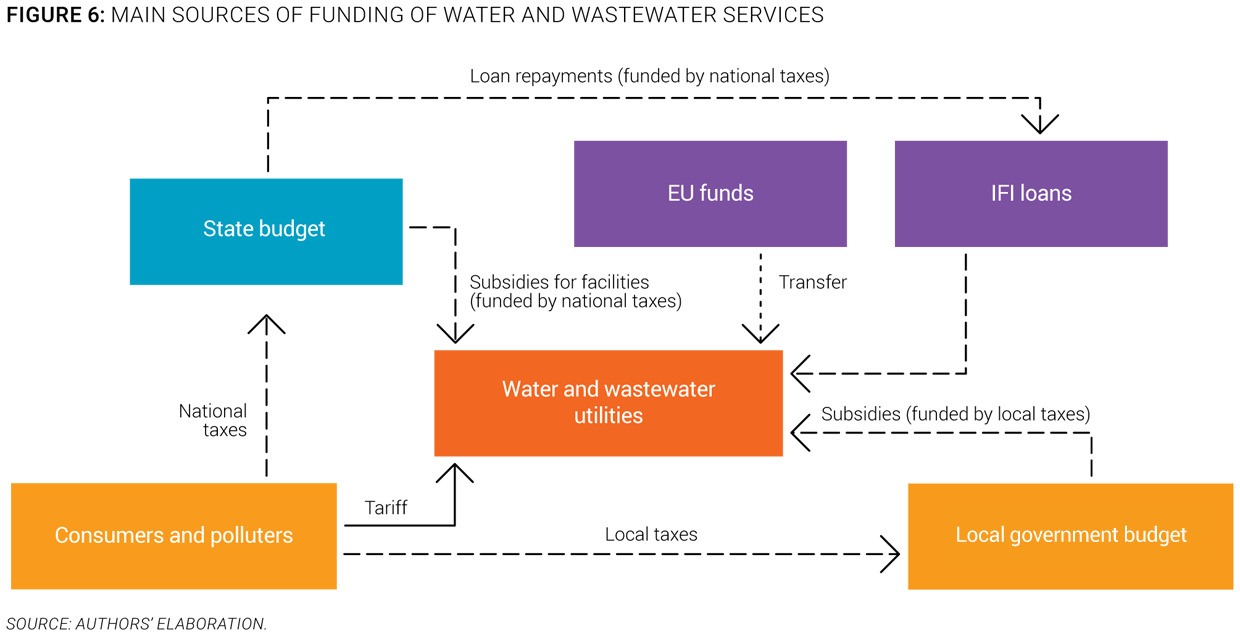
Investments. Half of current investments are funded by international loans. In 2005, Master Plan Strategies for water and wastewater infrastructure upgrading and completion were adopted for a period of 25 years. The Montenegrin Master Plans have estimated that €813 million (€560 million planned for wastewater and €253 million planned for water supply) would be needed from 2005 to 2029 to reach full EU standards and the environmental acquis. This overall investment target represents a yearly effort of 0.28% of GDP. During the first phase of the Master Plans (2005-2009), €109 million was invested in water and wastewater infrastructure, the equivalent of 0.95% of GDP and a yearly effort of 0.19% of GDP over the period. Half of the funding was provided by international loans, 45% by national subsidies from the central government budget, and 5% by local governments. Until the end of the first phase of the Master Plans, Montenegro followed the dynamics of financial investments projected in the strategic planning documents. However, in subsequent years, the economic crisis resulted in a decrease of funding from the central government budget and in a deceleration of investment trends (Figure 7).
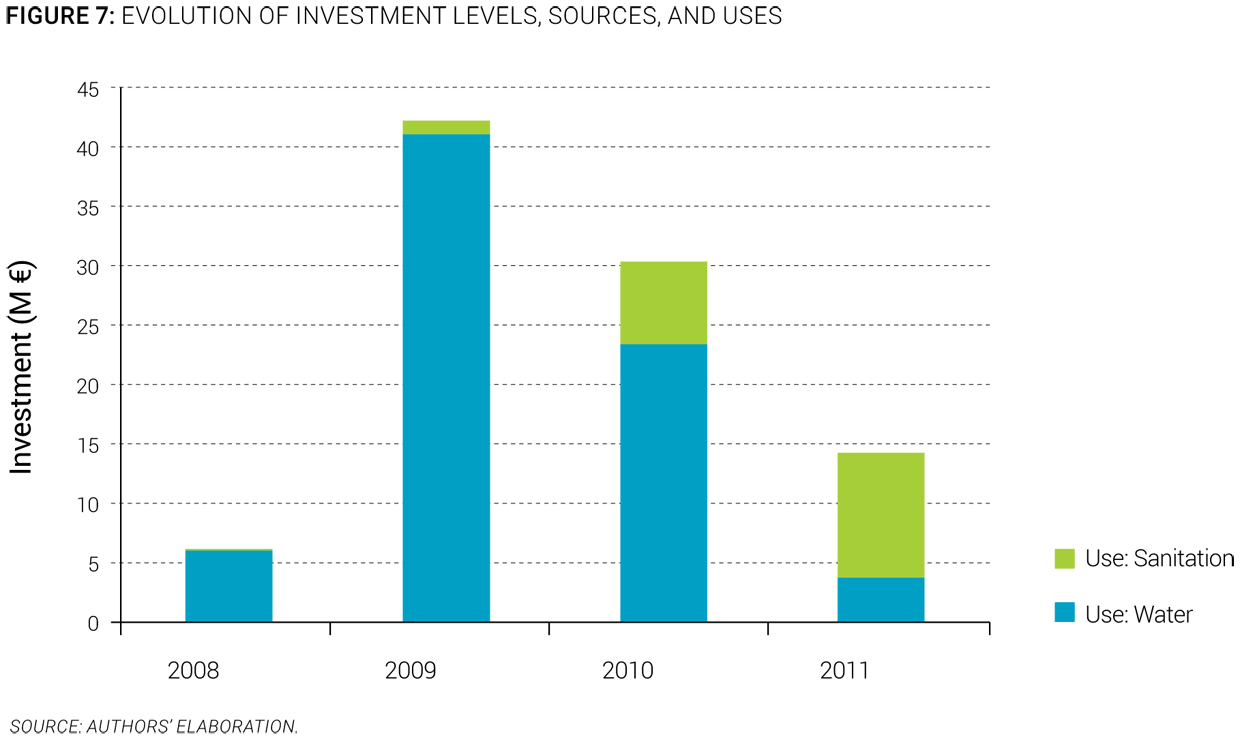
Cost Recovery and Affordability

Cost recovery. Low water tariffs hardly allow utilities to cover their operating costs. The average operating ratio of public water utilities is 0.76. However, it ranges from 2.24 to 0.46, showing great disparities among utilities. Low water tariffs do not allow water and wastewater services to cover the full cost of operation and maintenance, let alone investment costs. Cross-financing between domestic and industrial sectors (with industrial tariffs being 2.5 times higher than residential ones), and subsidies from national and local budgets, are necessary to cover both capital and operational expenditure. An added factor is that local governments tend to think that the price of water should remain low due to social and welfare concerns.
Tariffs. A significant increase in water tariffs is to be expected in the coming years. The average residential tariff is €0.67/m3 (Figure 8). The average industrial water tariff is 179% more expensive than the residential price, at €1.87/m3 (MRT 2012a).
Affordability. Affordability is not yet an issue for the majority of the population, since water is not expensive. Tariffs are kept low by local governments since water is considered a “social service.” Nevertheless, the average annual water bill potentially represents 1.6% of the average household income. The share of potential water and sanitation expenditure would represent 2.4% for the bottom 40%. This situation may change since important investments will be made in the future. However, these investments will be mainly funded by international loans. Hence, water tariff increases should mostly correspond to increases in operational expenses rather than increases in capital expenses.

WATER SECTOR SUSTAINABILITY AND MAIN CHALLENGES
In order to evaluate and reflect the sustainability of services in the region, an overall sector sustainability assessment has been established taking into account four main dimensions: access to services, quality of services, efficiency of services, and financing of services. Each of these dimensions is measured through three simple and objective indicators. For each indicator, best practice values are established by looking at the best performers in the region, and countries closest to those best performers are deemed to have a more mature sector. A more complete description of the methodology to assess the sector sustainability is included in the Annex of the State of the Sector Regional Report from the Danube Water Program. The outcomes of this assessment for the Montenegro water sector are displayed in Figure 9, which also shows average and best practices in the Danube region. As a result, the Montenegro sector sustainability score is 59, which is below the Danube average sustainability of 64, and is among the lower scores in the region. The assessment shows that, on average, the country performs well in terms of access to piped water and flush toilet, continuity of service and affordability. The main deficiencies of Montenegro’s water sector identified through the sector sustainability assessment are the operating cost ratio, staffing level, and wastewater treatment coverage.
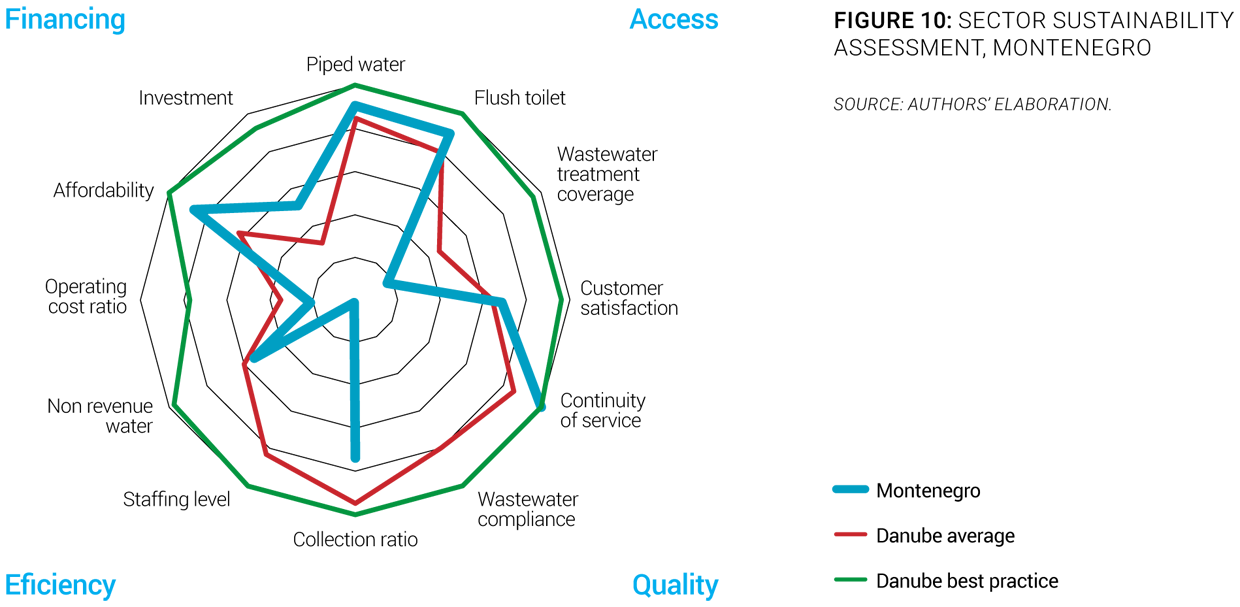
The main sector challenges are:
- Financing investments to upgrade the water and wastewater sector infrastructure. The second phase of the national Master Plan Implementation requires infrastructure investments for both water and sanitation in order to achieve EU directives compliance by 2030. Those investments are estimated at around €640 million over the next 15 years, or twice the current level of investment. Some EU-related funding (through the Instrument for Pre-accession Assistance, IPA) should be available to finance these investments. Efforts will have to be made to improve both the quality of drinking water delivered, since the compliance rate is only 85%, and the wastewater effective level of collection and treatment.
- Improving the efficiency and cost-effectiveness of water utilities. As stated in the Strategy for Public Administration Reform, efficiency and performance of water utilities are a challenge. To achieve this objective, nonrevenue water levels have to be lowered by improving the quality of metering devices and reducing network leakage through sound maintenance and renewal of assets. Overstaffing has also been identified by the Strategy as an issue that needs to be addressed, since it results in high labor costs, thereby increasing utility operational expenses.
- Implementing sound cost recovery principles. Water utilities do not generate sufficient revenues to ensure proper maintenance and sustainability of infrastructure. For many utilities, subsidies from central and local budgets are needed to cover routine operation and maintenance costs. This situation threatens the long-term sustainability and good performance of water and wastewater services. To reverse this trend, tariffs may need to be reviewed according to sound cost recovery principles, especially since the investments to upgrade the existing infrastructure will generate an increase in operational costs.
Montenegro Waters
The company “Vodacom” has started implementing a benchmarking project in the Coastal Municipalities of Montenegro. Information about technical and financial indicators and about service management and service quality is being collected. For each water utility, the benchmarking approach will help identify specific indicators that could be monitored in order to improve overall service quality and promote implementation of best practices.
SOURCES
- CIA. 2015. Central Intelligence Agency - The World Factbook. Accessed 2015. https://www.cia.gov/library/publications/the-world-factbook.
- EPA. 2015. Environmental Protection Agency of Montenegro. Accessed 2015. http://www.epa.org.me.
- Gallup. 2013. World Poll. Accessed 2015. http://www.gallup.com/services/170945/world-poll.aspx.
- Gov. ME. 2010. National Communication on Climate Change in Montenegro. Podgorica: Government of Montenegro.
- —. 2011. Strategy of Public Administration Reform in Montenegro. Podgorica: Government of Montenegro.
- ICPDR. 2010. Danube Facts and Figures: Montenegro. Vienna: International Commission for the Protection of the Danube River.
- —. 2015. International Commission for the Protection of the Danube River. Accessed 2015. http://www.icpdr.org.
- IJZCG. 2015. Institute for Public Health of Montenegro. Accessed 2015. http://www.ijzcg.me.
- MIF. 2015. Ministry of Finance of Montenegro. Accessed 2015. http://www.mif.gov.me/en/ministry.
- Monstat. 2011. Census of Population, Households and Dwellings in Montenegro. Podgorica: Statistical Office of Montenegro.
- —. 2013. Statistical Yearbook 2013. Podgorica: Statistical Office of Montenegro.
- MPR. 2015. Ministry of Agriculture and Rural Development of Montenegro. Accessed 2015. http://www.mpr.gov.me/en/ministry.
- MRT. 2005. Wastewater Strategic Master Plans for Central and Northern Regions and for the Coastal Area and Cetinje. Podgorica: Ministry of Sustainable Development and Tourism of Montenegro.
- —. 2012a. Information on Water Supply and Wastewater Management in Montenegro in 2012. Podgorica: Ministry of Sustainable Development and Tourism of Montenegro.
- —. 2012b. Agenda of Reform Appendix Excel Spreadsheet. Podgorica: Ministry of Sustainable Development and Tourism of Montenegro.
- —. 2015. Ministry of Sustainable Development and Tourism of Montengro. Accessed 2015. http://www.mrt.gov.me/en/ministry.
- UNDP/World Bank/EC. 2011. Regional Roma Survey. New York: United Nations Development Programme, World Bank and European Commission.
- World Bank. 2015. World Development Indicators. Accessed 2015. http://databank.worldbank.org/data/views/reports/tableview.aspx.

